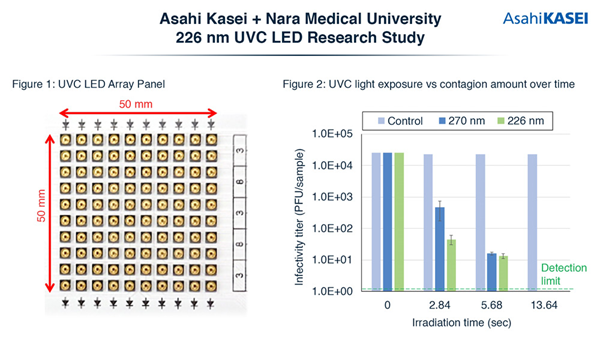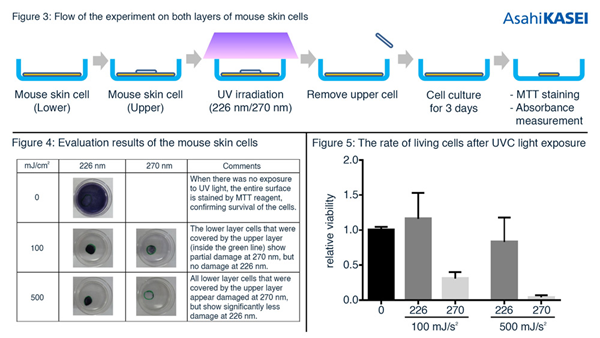The world's first bactericidal rate and safety test results for 226nm UVC LED are published!
发布时间:2021-06-17 16:14
来源:萤光创新
Asahi Kasei and Nara Medical University jointly studied the inactivation effect of 226nm UVC LED on Novel Coronavirus and its effects on animal skin cells, and recently announced the results of the study.
The results showed that the 226nm UVC LED rapidly inactivated the Novel CORONAVIRUS, and the effect of the 226nm UVC LED on animal skin cells was minimal compared to that of the 270nm UVC LED. The inactivation effect on Novel Coronavirus and its effect on animal skin cells were tested.
Germicidal test


As shown in the figure, 100 226nm UVC leds are placed on the panel in a 10×10 array, and a similar array of 270nm UVC LEDS is used as a comparison.
Researchers use a variety of appropriate and safe ways to control the active virus. The researchers injected a solution containing the active Novel Coronavirus into a petri dish and let it dry. The 226nm and 270nm UVC LED panel arrays were irradiated with the same output (440μW/cm2), then the virus was collected and the amount of infection was measured by a plaque technique (a method of measuring the volume of virus after infection). The results showed that 99.9% of the virus was inactivated by irradiation of two UVC LED wavelengths for about 6 seconds, as shown in Figure 2.

Security testing
In addition to the bactericidal effect, the effect of 226nm UVC LED on mouse skin cells was also tested with the aim of predicting the harm of 226nm UVC LED to animal skin compared to 270nm UVC LED.
The researchers divided mouse skin cells into two layers and exposed them to either 226nm UVC LED or 270nm UVC LED light at doses of 100mJ/cm2 and 500mJ/cm2.
After irradiation, the top cells are removed and the bottom cells are coated with MTT reagent dye (tetrazolium colorimetric method). The absorbance of the MTT reagent dye (tetrazolium colorimetric method) is tested to estimate the relative proportion of living cells in the bottom layer. The dark dye shows the number of living cells remaining.
The results showed that the effects of 226nm UVC LED at 100mJ/cm2 uv dose on mouse skin cells were negligible. Compared with 270nm UVC LED, 226nm UVC LED with uv dose of 500mJ/cm2 had significantly less effect on the underlying living cells, as shown in Figure 4 and Figure 5.
The above study results showed that 226nm UVC LED could rapidly inactivate the Novel coronavirus, and the effect of 226nm UVC LED on animal skin cells was significantly less than that of the existing 270nm UVC LED, which further indicated that the effect of 226nm UVC LED on animal skin cells was significantly less than that of 270nm UVC LED. It may be safe to use a 226nm UVC LED to sterilize an arm or an object with someone near it.
In the past two years, in order to promote the universal application of UVC LED, manufacturers around the world accelerate the breakthrough of UVC LED technology, including the research of shorter wavelength UVC LED. In the future, UVC LED will inevitably become a trend. Qingdao Fluorescein focuses on the research and industrialization of UV LED application technology, and its application fields include: analysis and detection, photochemical catalysis, anti-counterfeit detection, communication positioning, disinfection and sterilization, etc., so it has attracted much attention in the industry. It is believed that with the improvement of UVC LED technology, more related technology research and experimental tests will be paid more attention in the future.

文章出自:LEDinside Janice
文章关键字:UVC、UVC LED、深紫外、紫外杀菌、深紫外 LED、水杀菌、空气杀菌、流动水杀菌
文章关键字:UVC、UVC LED、深紫外、紫外杀菌、深紫外 LED、水杀菌、空气杀菌、流动水杀菌
